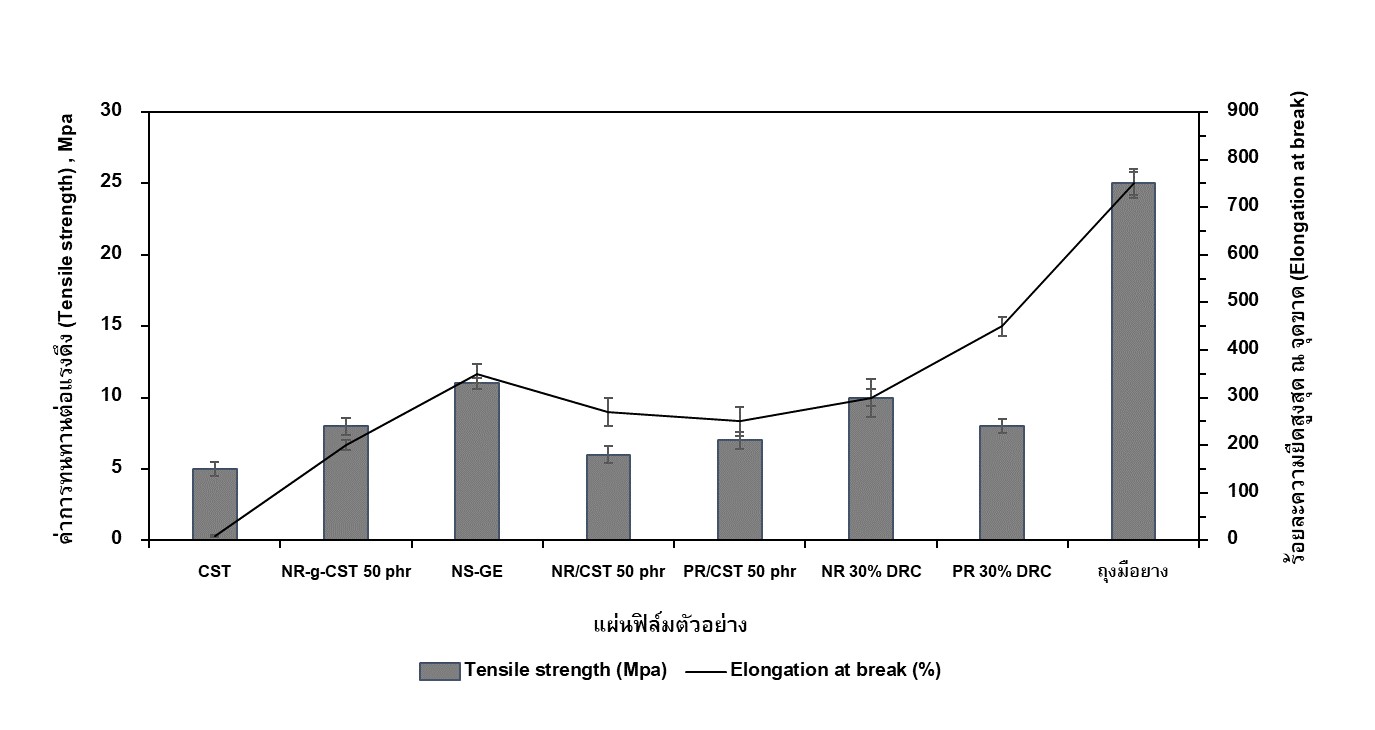การศึกษาสัณฐานวิทยา ความเสถียรทางความร้อน และสมบัติเชิงกลของการย่อยสลายทางชีวภาพของยางธรรมชาติดัดแปร
Main Article Content
Abstract
Phetdaphat Boonsuk
รับบทความ: 8 กันยายน 2567; แก้ไขบทความ: 29 มกราคม 2568; ยอมรับตีพิมพ์: 16 กุมภาพันธ์ 2568; ตีพิมพ์ออนไลน์: 19 มิถุนายน 2568
บทคัดย่อ
งานวิจัยนี้ศึกษาสัณฐานวิทยา สมบัติทางความร้อน และสมบัติเชิงกลของการย่อยสลายทางชีวภาพในดินของยางธรรมชาติดัดแปร โดยนำยางธรรมชาติ (natural rubber: NR) กราฟต์แป้งมันสำปะหลังดัดแปร (cassava starch: CST) ที่มีสัดส่วน CST 50 phr (NR–g–CST 50 phr) เปรียบเทียบกับแป้งมันสำปะหลังดัดแปรร้อยละ 10 โดยน้ำหนัก (CST) ยางธรรมชาติกราฟต์กับแป้งมันสำปะหลังดัดแปรที่มีสัดส่วน CST 50 phr และผสมกลีเซอรอล (glycerol: GE) ร้อยละ 3 โดยน้ำหนัก (พอลิเมอร์ผสม NS–GE) ยางธรรมชาติผสมกับแป้งมันสำปะหลังดัดแปรที่มีสัดส่วน CST 50 phr (พอลิเมอร์ผสม NR/CST 50 phr) ยางพรีวัลคาไนซ์ (pre–valcanized rubber: PR) ผสมกับแป้งมันสำปะหลังดัดแปรที่มีสัดส่วน CST 50 phr (พอลิเมอร์ผสม PR/CST 50 phr) ยางธรรมชาติ 30%DRC (dry rubber content) ยางพรีวัลคาไนซ์ 30%DRC และถุงมือยาง จากการศึกษาโครงสร้างสัณฐานวิทยาพบว่าพื้นผิวของแผ่นฟิล์มทุกตัวอย่างมีลักษณะขรุขระ มีรู มีรูพรุนมีรอยแตกมากขึ้น และสังเกตเห็นเส้นใยราบนพื้นผิวตัวอย่างเมื่อฝังดินนานขึ้น จากการศึกษาสมบัติทางความร้อนก่อนการฝังดิน พบว่า เทอร์โมแกรมของ NR–g–CST 50 phr เลื่อนไปยังที่อุณหภูมิสูงขึ้นกว่า NS–GE, NR/CST 50 phr และ PR/ CST 50 phr ในช่วงอุณหภูมิ 330–500 องศาเซลเซียส และเมื่อศึกษาสมบัติทางความร้อนหลังการฝังดิน แผ่นฟิล์มทุกตัวอย่างทนความร้อนได้ลดลงเมื่อฝังดินนานขึ้น และจากการศึกษาสมบัติการทนทานต่อแรงดึง (tensile strength) ของ NS–GE NR/CST 50 phr และ PR/ CST 50 phr ในช่วงอุณหภูมิ 330–500 องศาเซลเซียส และเมื่อศึกษาสมบัติทางความร้อนหลังการฝังดิน แผ่นฟิล์มทุกตัวอย่างทนความร้อนได้ลดลงเมื่อฝังดินนานขึ้น และจากการศึกษาสมบัติการทนทานต่อแรงดึง (tensile strength) ของ CST NR–g–CST 50 phr NS–GE NR/CST 50 phr PR/CST 50 phr NR 30%DRC PR 30%DRC และถุงมือยาง ก่อนการฝังดินพบว่าค่าการทนทานต่อแรงดึงเท่ากับ 5±0.5, 8±0.6, 11±0.4, 6±0.6, 7±0.6, 10±0.6, 8±0.5, และ 25±0.8 และค่าความยืดสูงสุด ณ จุดขาดเท่ากับ 10±2, 200±10, 350±20, 270±30, 250±30, 300±40, 450±20 และ 750±30 ตามลำดับ สรุปได้ว่าการดัดแปรยางธรรมชาติโดยนำยางธรรมชาติ (NR) กราฟต์แป้งมันสำปะหลังดัดแปร (CST) ที่มีสัดส่วน CST 50 phr (NR–g–CST 50 phr) สามารถนำไปใช้เป็นแนวทางในการปรับปรุงและพัฒนาผลิตภัณฑ์จากยางธรรมชาติให้สามารถย่อยสลายทางชีวภาพได้ และจัดการของเสียจากผลิตภัณฑ์ยางธรรมชาติในสิ่งแวดล้อม ทนต่อความร้อน และทนทานต่อแรงดึงและความยืดสูงสุด ณ จุดขาด ได้ดี
คำสำคัญ: การย่อยสลายทางชีวภาพ ยางธรรมชาติ แป้งมันสำปะหลัง การดัดแปรโครงสร้าง ยางธรรมชาติย่อยสลายได้ทางชีวภาพ
Abstract
This research studied the morphology, thermal properties and mechanical properties of biodegradation in soil of modified natural rubber by natural rubber (NR) grafted with modified cassava starch (cassava starch: CST) at the ratio of 50 phr (NR–g–CST 50 phr) were compared with modified cassava starch 10% by weight (CST), natural rubber blended with modified cassava starch at the ratio of 50 phr (NR/CST 50 phr), natural rubber grafted with modified cassava starch at the ratio of 50 phr and glycerol 3% by weight (NS–GE), pre–vulcanized rubber blended with modified cassava starch at the ratio of 50 phr (PR/CST 50 phr), natural rubber 30%DRC (NR 30%DRC), pre–vulcanized rubber 30%DRC (PR 30%DRC) and rubber gloves. From the study of the morphological structure, it was found that the surface of every film sample was rough, had more holes, pores, cracks and fungal hyphae were observed on the surface when buried in the soil for a long time. From the study of the thermal properties before burial, it was found that thermogram of NR–g–CST 50 phr shifts to a higher temperature than NS–GE, NR/CST 50 phr, and PR/CST 50 phr in the temperature range from 330–500°C. By studying thermal properties after burial, it was found that the decomposition temperature decreased when buried in the soil for a long time. As a consequence of studying the mechanical properties, it was found that the tensile strength of CST, NR–g–CST 50 phr, NS–GE, NR/CST 50 phr, PR/CST 50 phr, NR 30%DRC, PR 30%DRC and rubber gloves were 5±0.5, 8±0.6, 11± 0.4, 6±0.6, 7±0.6, 10±0.6, 8±0.5 and 25±0.8, and the maximum elongation at break were 10±2, 200±10, 350±20, 270±30, 250±30, 300±40, 450±20 and 750±30, respectively. In conclusion, the modification of natural rubber by grafting natural rubber (NR) with modified cassava starch (CST) with a proportion of CST 50 phr (NR–g–CST 50 phr) could be used as a guideline for improvement and development natural rubber products were biodegradable and managed waste from natural rubber and its products in the environment. It was thermal stability, tensile strength and maximum elongation at break properties well.
Keywords: Biodegradation, Natural rubber, Cassava starch, Structure modification, Biodegradable natural rubber
Downloads
Article Details

This work is licensed under a Creative Commons Attribution-NonCommercial 4.0 International License.
References
Boonsuk, P. (2024). Study on biodegradation of modified natural rubber to serve as guidelines for natural rubber waste management. Journal of Research Unit on Science, Technology and Environment for Learning 15(1): 25–37. (in Thai)
Bosco, F., and Mollea, C. (2021). Biodegradation of natural rubber: Microcosm study water air soil pollution. Water and Air Soil Pollution 232(6): 1–15.
Bosco, F., Antonioli, D., Casale, A., Gianotti, V., Mollea, C., Laus, M., and Malucelli, G. (2018). Biodegradation of unvulcanized natural rubber by microorganisms isolated from soil and rubber surface: A preliminary study. Bioremediation Journal 22: 43–52.
Chairat, N., Kamontam, U., and Natthawan, S. (2018). Rubber gloves biodegradation by a consortium, mixed culture and pure culture isolated from soil samples. Brazilian Journal of Microbiology 49: 481–488.
Chaisuwan, K., Anurakumphan, D., Hemmanee, S., Ruamcharoen, J., and Leelakriangsak, M. (2023). Soil burial degradation of starch–based film on microbial load and plant growth. Journal of Sustainability Science and Management 18(3): 110–124.
Chantawee, K., and Riyajan, S. (2019). Effect of glycerol on the physical properties of carboxylated styrene butadiene rubber/cassava starch blend films. Journal of Polymers and the Environment 27: 50–60.
Jankovic, B. (2013). Thermal characterization and detailed kinetic analysis of Cassava starch thermo–oxidative degradation. Carbohydrate Polymers 95(2): 621–629.
Mohd, F. A. R., Arjulizan, R., Muhammad, A. M., and Azura, A. R. (2020). Biodegradable gloves for waste management post–covid–19 outbreak: A shelf–life prediction. ACS Omega 5(46): 30329–30335.
Nevoralova, M., Koutny, M., Ujcic, A., Stary, Z., Sera, J., Vlkova, H., Slouf, M., Fortelny, I., and Krulis, Z. (2020). Structure characterization and biodegradation rate of poly(ε–caprolactone)/starch blends. Frontiers in Materials 7: 1–14.
Riyajan, S. (2015). Robust and biodegradable polymer of cassava starch and modified natural rubber. Carbohydrate Polymers 134: 267–277.
Riyajan, S. (2017). Physical property testing of a novel hybrid natural rubber–graft–cassava starch/sodium alginate bead for encapsulating herbicide. Polymer Testing 58: 300–307.
Riyajan, S., and Patisat, S. (2018). A novel packaging film from cassava starch and natural rubber. Journal of Polymers and the Environment 26: 2845–2854.
Riyajan, S., Sasithronsonti, Y., and Phinyocheep, P. (2012). Green natural rubber–g–modified starch for controlling urea release. Carbohydrate Polymers 89: 251–258.
